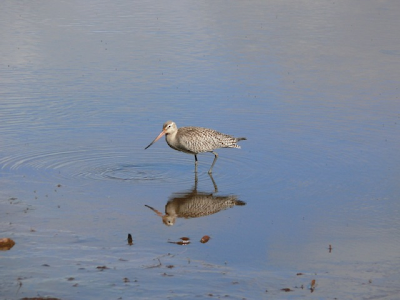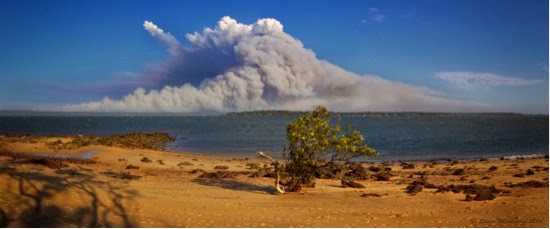Foreign Feathered Friends
It seems that the plight of immigrants and how Australia should welcome - or reject - them has dominated the news for months lately. While all this has been going on North Stradbroke Island has been quietly providing a temporary home to thousands of undocumented and hungry arrivals. Beginning in early September, Amity Point, 18 Mile Swamp and other wetlands across Straddie and throughout Moreton Bay have been providing a temporary refuge to thousands of migratory shorebirds.
Shorebirds, also known as waders, are a diverse group of birds commonly seen feeding in intertidal areas or on the fringes of freshwater wetlands. They generally have long legs in relation to their body size, no webbing on their feet and they do not swim. But they can certainly fly!
Most of the migrants spend the months of June and July on their breeding grounds in the northern parts of Siberia, Alaska, China and Mongolia. They breed in areas where melting snow brings masses of insects, providing a vital food source for self-feeding chicks. With the onset of winter in the Northern Hemisphere and the depletion of food sources, the breeding adults, followed a short time after by their offspring, set off for the feeding grounds of Australia and other warm southern parts. The birds travel remarkable distances of up to 25,000 kilometres each year, flying through extreme weather and avoiding predators. The smallest of these birds have bodies no larger than a hen’s egg, yet they still manage the journey. The birds fly at more than 60 km/hr, for three days and nights and for up to 10,000 km non-stop! Shorebirds make the journey in several weeks, stopping two or three times along the way. In doing this, they use favourable weather patterns when they can, but even so will commonly lose 40 per cent of their bodyweight flying. When they stop, they must 'refuel': they feed and rest to build up energy reserves. At these times they may increase their body weight by more than 70 per cent before undertaking the next marathon stage of their journey. The birds navigate a chain of wetlands from the northern to southern hemispheres along what is known as the East Asian-Australasian Flyway.
Shorebirds, also known as waders, are a diverse group of birds commonly seen feeding in intertidal areas or on the fringes of freshwater wetlands. They generally have long legs in relation to their body size, no webbing on their feet and they do not swim. But they can certainly fly!
 |
| Bar Tailed Godwit on Home Beach. |
Migrating shorebirds need huge amounts of energy to complete their journey. One of the best-studied species, the eastern curlew, dramatically builds up its body weight just prior to migration. During its 13,000 kilometre flight from Siberia to Australia it will burn 40 percent of its body weight. This is equivalent to an 80 kilogram person running 16 million kilometres almost non-stop and losing 32 kilograms, twice a year!
The beaches, mangroves, mudflats, seagrass beds and coastal wetlands of Stradbroke Island, Bribie and many other areas in Moreton Bay are often the first Australian sites used by shorebirds on their southern journey and the last site before they return north. Around 40,000 shorebirds migrate to Moreton Bay each year.
Once they arrive the shorebirds devote themselves to eating and regaining weight in preparation for their return to the North. During summer at low tide, regardless of day or night, the birds feed constantly – pecking and probing for worms, insects and crustaceans. With their highly variable and specialized bills they feed around intertidal flats, beaches, rocky headlands and along the fringes of freshwater wetlands. As the incoming tide cover these feeding areas, they begin to congregate in large numbers in relatively safe roost sites nearby. These roost sites provide areas where they can interact, preen, digest their food and rest while they wait for the ebbing tide to again expose their feeding grounds.
Following the birds’ summer ‘holiday’ at Stradbroke and around Moreton Bay, their numbers dramatically decrease during March and April as the adults begin their epic journey back to the Northern hemisphere breeding grounds. Each year, around 15 percent of the migrating shorebirds that visit Moreton Bay in the summer remain for the whole year. This includes most of the first year birds that are too young to breed or adults that are too weak for the northern journey. From February to August these birds are joined by the only shorebird of Moreton Bay that undertakes an east-west migration - the Double-banded Plover from New Zealand which can sometimes be sighted at Flinders Beach and Amity.
These temporary visitors share the beaches and wetlands with Straddie's resident shorebirds and water birds which can be seen all year round. Some of the most recognizable species include the pied oystercatcher, bush stone-curlew, lapwings, terns and red-capped plover and our resident waterbirds – the herons, egrets, ibis and spoonbills. The vulnerable beach stone-curlew can also be found on Stradbroke while another rare shorebird, the sooty oystercatcher, is occasionally spotted on rocky beach outcrops on Frenchman’s Beach.

